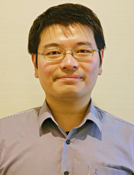2021/12/09(Thu)
10:30 -12:00
五樓第一會議室 5F, 1st Meeting Room
視訊演講 Video Seminar [ Meeting Link / ID: 2515 714 6399 / Password: 123456 ]

- 實體與視訊演講同時進行。
- Both physical seminar and virtual seminar are available.
Title
Charge transport of quantum channels in nanoscale systems
Speaker
徐晨軒博士 (RIKEN Center for Emergent Matter Science, Japan) Dr. Chen-Hsuan Hsu (RIKEN Center for Emergent Matter Science, Japan)Abstract
One-dimensional quantum channels appear in various nanoscale systems, such as nanowires, nanotubes, and boundaries of topological materials. Recently, these systems have drawn great attention due to their potential for stabilizing Majorana zero modes [1,2], which can be utilized to form quantum bits as elements for quantum computation. In these systems, charge transport provides a straightforward way to probe and characterize the quantum channels. In this colloquium, I will discuss charge transport properties of the quantum channels in three examples. The first example is topological boundary channels, in which helical liquids emerge as a result of spin-momentum locking and Coulomb interaction between electrons [3]. While the linear-response conductance was expected to be quantized in the absence of disorder-induced elastic backscattering, magnetic impurities, such as nuclear spins [4,5], or other resistance sources [3] can lead to a substantial conductance deviation in realistic samples. In addition to the helical systems, nonhelical quantum channels formed in nanowires with strong spin-orbit coupling also exhibit interesting transport properties. In the second example, I will turn to a spin-orbit-coupled nanowire in which the lowest two transverse subbands are populated. Due to the interplay between Coulomb interaction and a spin-orbit-induced helical field, novel backscattering processes result in partial gaps, leading to unusual plateaus and conductance dips [6]. The positions and values of these dips are independent of material parameters, leading to universal conductance dips and resembling the fractional quantum Hall states. In the third example, I will turn to the one-subband regime and discuss the effects of spin-orbit-induced band distortion on the current-bias curves. The findings can be summarized in the form of the universal scaling curve with an exponent depending on the impurity type, the Coulomb interaction strength and the band distortion [7]. The results can serve as guidance for quantifying the interaction strength of spin-orbit-coupled wires [8], which is crucial for identifying a promising platform for topological states of matter.
References:
[1] Chen-Hsuan Hsu et al., Phys. Rev. Lett. 121, 196801 (2018).
[2] Chen-Hsuan Hsu et al., Phys. Rev. B 92, 235435 (2015).
[3] Chen-Hsuan Hsu et al., Semicond. Sci. Technol. 36, 123003 (2021).
[4] Chen-Hsuan Hsu et al., Phys. Rev. B 96, 081405(R) (2017).
[5] Chen-Hsuan Hsu et al., Phys. Rev. B 97, 125432 (2018).
[6] Chen-Hsuan Hsu et al., Phys. Rev. Research 2, 043208 (2020).
[7] Chen-Hsuan Hsu et al., Phys. Rev. B 100, 195423 (2019).
[8] Yosuke Sato, Sadashige Matsuo, Chen-Hsuan Hsu et al., Phys. Rev. B 99, 155304 (2019).
Language
演講語言 (Language): in English